
今天,我们的生活、工作和娱乐方式与几十年前大不相同,这在很大程度上要归功于现在囊括了地球上大多数人的连接网络。同样,今天我们正处于一场新的技术革命的开端:互联网正在进入物理空间——建筑和设计的传统领域——成为“物联网”(IoT)。因此,它正在向各种应用敞开大门。这些应用——与互联网第一波浪潮的情况类似——可以涵盖许多领域:从能源到移动生活和出行(mobility),从生产制造到社会参与。在本次讲座中,Carlo Ratti教授将通过介绍他在麻省理工学院的研究平台“可感知城市实验室”(Senseable City Laboratory)及其设计事务所Carlo Ratti Associati的项目,对上述问题和趋势进行评论。
The way we live, work, and play is very different today than it was just a few decades ago, thanks in large part to a network of connectivity that now encompasses most people on the planet. In a similar way, today we are at the beginning of a new technological revolution: the Internet is entering the physical space – the traditional domain of architecture and design – becoming an “Internet of Things” or IoT. As such, it is opening the door to a variety of applications that – in a similar way to what happened with the first wave of the Internet - can encompass many domains: from energy to mobility, from production to citizen participation. The contribution from Prof. Carlo Ratti will address these issues from a critical point of view through projects by the Senseable City Laboratory, a research initiative at the Massachusetts Institute of Technology, and the design office Carlo Ratti Associati.
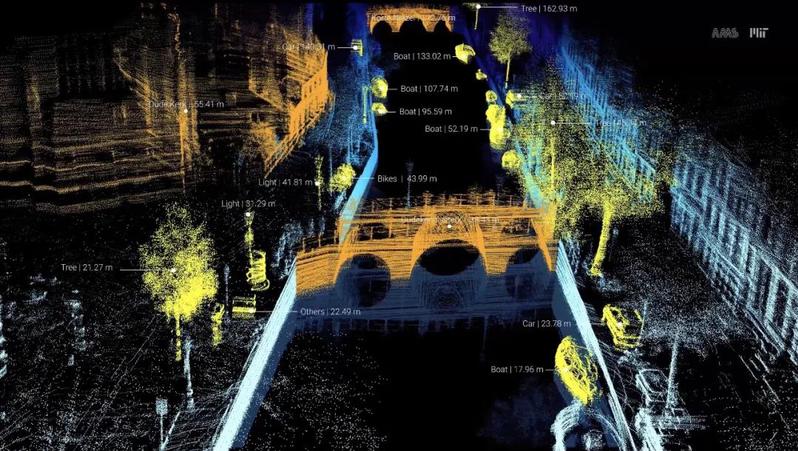
阿姆斯特丹运河, Roboat项目
时间 | Date & Time
2020年11月19日 | Nov 19, 2020
19:00-20:00
讲座语言 | Language
英语 | English
线上地点 | Virtual Venue
ZOOM 会议
ZOOM ID 开放给上科大师生,请注意查收学校邮件
ZOOM ID Available to ShanghaiTech Community Only, Please Check Your ShanghaiTech Email
B站直播 | Live @ Bilibili:22592211
主讲人 | Speaker

Prof. Carlo Ratti
作为一名建筑师和工程师,Carlo Ratti教授在麻省理工学院(MIT)任教,是可感知城市实验室(Senseable City Lab)的主任,同时也是国际设计和创新工作室Carlo Ratti Associati的创始人之一。他毕业于都灵理工大学和巴黎国立交通学院,后在英国剑桥大学获得硕士和博士学位。
An architect and engineer by training, Professor Carlo Ratti teaches at the Massachusetts Institute of Technology (MIT), where he directs the Senseable City Lab, and is a founding partner of the international design and innovation office Carlo Ratti Associati. He graduated from the Politecnico di Torino and the École Nationale des Ponts et Chaussées in Paris, and later earned his MPhil and PhD at the University of Cambridge, UK.
作为倡导新技术对城市生活和设计会产生重大变革的领军人物之一,Carlo Ratti教授与他人合著了500多本出版物,包括《明日之城》(The City of Tomorrow,耶鲁大学出版社,与Matthew Claude合著),并拥有多项技术专利。他的文章和采访经常见诸国际媒体,包括《纽约时报》、《华尔街日报》、《华盛顿邮报》、《金融时报》、BBC等。他的作品曾在世界各地展出,如威尼斯双年展、巴塞罗那设计博物馆、伦敦科学博物馆、罗马的MAXX和纽约现代美术馆MoMA。
A leading voice in the debate on new technologies’ impact on urban life and design, Carlo has co-authored over 500 publications, including The City of Tomorrow (Yale University Press, with Matthew Claudel), and holds several technical patents. His articles and interviews have appeared on international media including The New York Times, The Wall Street Journal, The Washington Post, Financial Times, Scientific American, BBC, Project Syndicate, Corriere della Sera, Il Sole 24 Ore, Domus. His work has been exhibited worldwide at venues such as the Venice Biennale, the Design Museum Barcelona, the Science Museum in London, MAXXI in Rome, and MoMA in New York City.
Carlo Ratti曾入选《时尚先生》(Esquire)杂志“上智名单”(Best and Brightest),及Thames & Hudson出版社评选的“60位塑造人类创意未来的创新者”名单。《蓝图》(Blueprint Magazine)杂志将他列为“将改变设计世界的25位人物之一”,《福布斯》将他列为“你需要知道的名字”之一,《快速公司》(Fast Company)杂志将他列为“美国最具影响力的50位设计师之一”。他还被《连线》(Wired)杂志收录于“智者名单(Smart List):50位将改变世界的人”。他的三个设计项目——数字水亭、哥本哈根智能自行车轮和Scribit智能绘画机器人——曾先后被《时代》杂志列入“年度最佳发明”名单。
Carlo has been featured in Esquire Magazine’s ‘Best & Brightest’ list and in Thames & Hudson’s selection of ‘60 innovators’ shaping our creative future. Blueprint Magazine included him as one of the ‘25 People Who Will Change the World of Design’, Forbeslisted him as one of the ‘Names You Need To Know’ and Fast Company named him as one of the ‘50 Most Influen-tial Designers in America’. He was also featured in WiredMagazine’s ‘Smart List: 50 people who will change the world’. Three of his projects – the Digital Water Pavilion, the Copenhagen Wheel and Scribit – have been included byTIME Magazine in the list of the ‘Best Inventions of the Year’.
Carlo Ratti教授曾在2011年与2015年在TED上做演讲,曾担任莫斯科的Strelka媒体、建筑和设计学院的主任、宝马古根海姆实验室策展人,是首个获昆士兰政府任命的“驻场创新者”(”Innovator in Residence”)。他是2015年米兰世博会未来食品区馆的策展人以及2019年深港城市\建筑双城双年展“城市之眼”部分的总策展人。目前,他正担任世界经济论坛“全球未来城市与城市化”委员会的联合主席。
Carlo has been a presenter at TED (in 2011 and 2015), program director at the Strelka Institute for Media, Architecture and Design in Moscow, curator of the BMW Guggenheim Pavilion in Berlin, and was named Inaugural Innovator in Residence by the Queensland Government. He was the curator of the Future Food District pavilion for the 2015 World Expo in Milan and chief curator of the ‘Eyes of the City’ section at the 2019 UABB Biennale of Architecture and Urbanism of Shenzhen. He is currently serving as co-chair of the World Economic Forum’s Global Future Council on Cities and Urbanization.
代表作品 | Select Projects
(信息编译自网络)
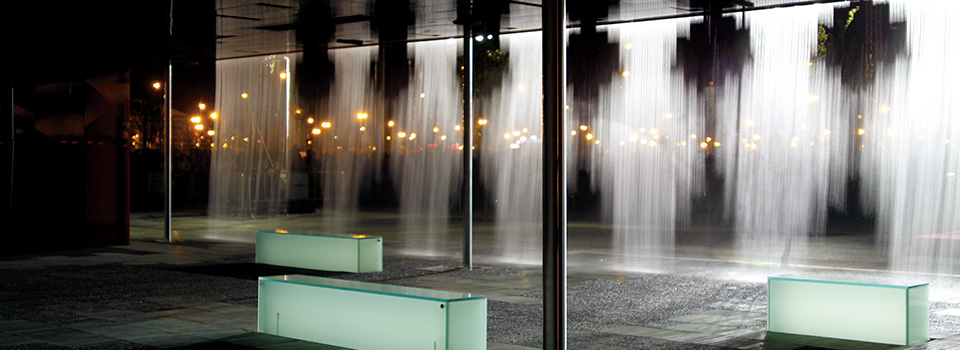
数字水亭 | Digital Water Pavilion (2008)
数字水亭建于2008年萨拉戈萨世博会的入口处,是由数字控制的水幕组成的交互式结构。这一空间被用作咖啡馆兼问讯处,改造前原本是旅游办公室。该结构运用了当年世博会主题“水”作为建筑元素。墙壁由数字控制的水滴组成,水滴形成书法、图案、或空间入口。这样一个交互式且可重新组合的空间中,每面墙都可能成为入口或出口,而内部隔断可根据容纳的人数而变化。唯一的物质元素是两个盒子和屋顶,屋顶像窗帘一般可垂直移动或平展在地面,从而可以使整个展馆快速消失。
The Digital Water Pavilion is an interactive structures made of digitally-controlled water curtains, built at the entrance of the 2008 Expo in Zaragoza. What was office space for tourism during the event in 2008 now houses a cafe and an info-box on the Milla Digital project. The challenge was to use water – the theme of Expo 2008 – as an architectural element. The walls are composed of digitally controlled water droplets, which can generate writing or patterns or access to spaces. The result is a space that is interactive and reconfigurable in that each wall can potentially become an entrance or exit, while the internal partitions can shift depending on the number of people present. The only material elements are the two boxes and the roof, which is a sort of curtain that can move vertically and flatten to the ground, removing the presence of the entire pavilion.
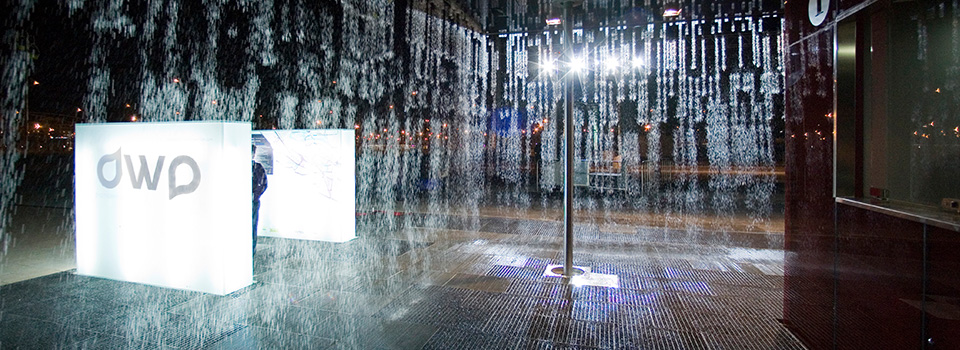
https://carloratti.com/project/digital-water-pavilion/
哥本哈根车轮 | The Cophenhagen Wheel (2009)

哥本哈根车轮将普通自行车迅速转变为混合动力电动自行车,还可以用作移动传感单元,捕获骑行和制动时散发的能量,并将其保存起来以备不时之需。它还可以实时绘制污染水平,交通拥堵和道路状况的地图。车轮通过智能手机进行控制,其感应单元可以捕获骑行者的努力程度以及有关周围环境的信息,包括路况,一氧化碳,NOx,噪音,环境温度和相对湿度,成为骑行者日常生活的延伸。
Smart, responsive and elegant, the Copenhagen Wheel is a new emblem for urban mobility. It transforms ordinary bicycles quickly into hybrid e-bikes that also function as mobile sensing units. The Copenhagen Wheel allows you to capture the energy dissipated while cycling and braking and save it for when you need a bit of a boost. It also maps pollution levels, traffic congestion, and road conditions in real-time. Controlled through your smart phone, the Copenhagen Wheel becomes a natural extension of your everyday life. You can use your phone to unlock and lock your bike, change gears and select how much the motor assists you. As you cycle, the wheel’s sensing unit is also capturing your effort level and information about your surroundings, including road conditions, carbon monoxide, NOx, noise, ambient temperature and relative humidity. Access this data through your phone or the web and use it to plan healthier bike routes, to achieve your exercise goals or to meet up with friends on the go.
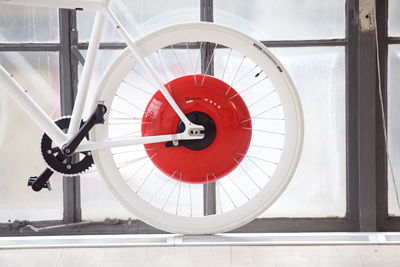
http://senseable.mit.edu/copenhagenwheel/
智能绘画机器人 | Scribit(2018)
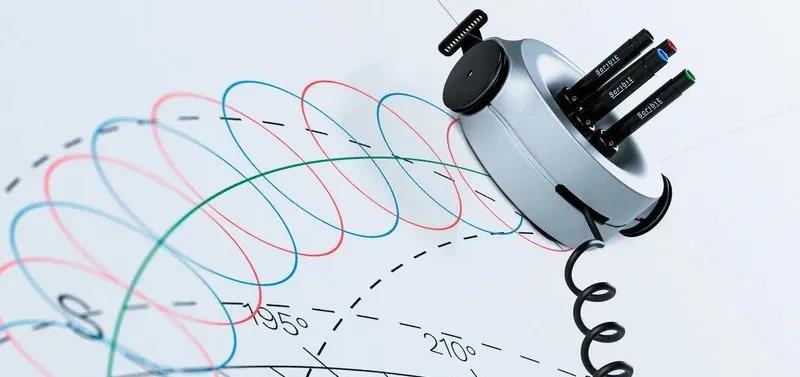
Scribit智能机器人不仅可以在墙上写字画画,而且还可以擦除墙上已经存在的任何东西,不论是强迫症还是天马行空的绘制者都能找到令自己爽到的功能。Scribit会同时运行四支记号笔,并使用会随着热量消失的特殊墨水。因此它并不是特别复杂的机器人——显然在墙上涂鸦就会用到记号笔;而引入受热会消失的墨水令机器人在擦除功能上有了创新。它能像魔术师一样把写下来的东西擦得一干二净。这使得Scribit在竞争对手中脱颖而出,因为画图非常容易,但是擦除功能令它成为了完整的产品。
The Scribit is known as a write and erase robot, as this robot not only writes on your wall, but also helps in erasing anything that is on the wall already, and that’s for those with OCD, people who mostly like everything to be neat and clean, but for the messed up ones, there is the draw option. Scribit uses four markers simultaneously, and erases with the help of a special ink that vanishes with heat. So that wasn’t such a rocket science, most part of its working is simple logic. Like what device can draw on a wall? Obviously a marker, for the erasing part there has been some innovations with the introduction of an ink, which vanishes when exposed to heat, and works like any magician whipping out a text like it wasn’t there ever, which is one of the best feature of scribit, making it stand out strong in the market with its competitors, because drawing something is pretty easy, but erasing it is what makes it a complete product.
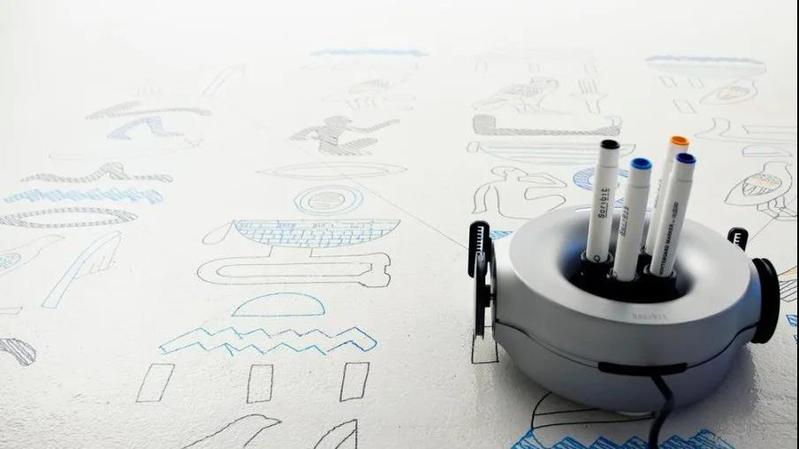
https://carloratti.com/project/scribit/
阿姆斯特丹无人驾驶小艇 | Roboat (2020)
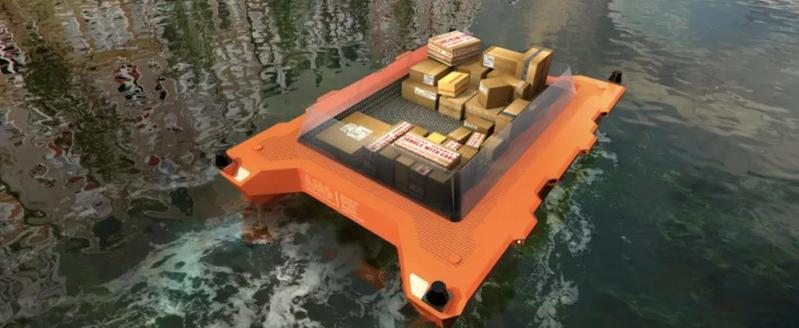
Roboat项目是一个从2016年启动的5年计划,是世界上第一个在国际大都市实验和实施的自动驾驶船只的研究项目。它创建了一个动态的基础架构以运输货物和人员,并使用传感器感知阿姆斯特丹的运河环境。该项目复合了多个领域的同步创新——如即时装配、传感和废物清理,以顶尖的研究和专业知识赢得了各方的一致支持。
Roboat is the world’s first major research program on autonomous floating vessels in metropolitan areas, scheduled to last five years from 2016. It allows for creating dynamic infrastructures, transportation of goods and people, and environmental sensing on Amsterdam’s canals. The project allows for innovations in various domains, stands strong with top research and knowledge expertise and receives univocal support. Areas of innovation are for instance assembly, sensing and waste removal.

http://roboat.org/
集装箱改装重症监护舱 | CURA(2020)
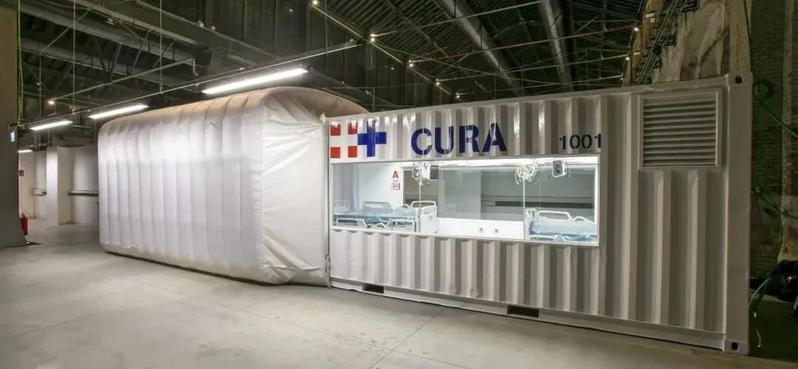
第一台CURA吊舱于2020年4月19日在意大利北部都灵新设立的临时医院被安装并投入使用。CURA(“呼吸疾病互联单位”的缩写,亦为拉丁语中的“Cure”)提出了一种快速部署的解决方案,以扩大急救设施并减轻治疗被冠状病毒感染的患者的医疗系统的压力。CURA力求做到像医院帐篷一样快速安装,但又像普通隔离病房一样安全工作。
CURA (acronym for “Connected Units for Respiratory Ailments” and also “Cure” in Latin) proposes a quick-to-deploy solution to expand emergency facilities and ease the pressure on healthcare systems treating patients infected by coronavirus. CURA strives to be as fast to be mounted as a hospital tent, but as safe as a regular isolation ward to work in. The first CURA pod has been installed on April 19th, 2020 at a new temporary hospital set up in Turin, northern Italy.
https://carloratti.com/project/cura/
媒体与技术支持:DIV Lab


